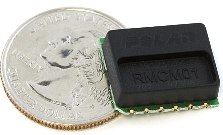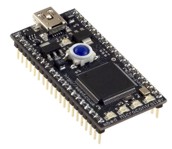Jaspers Heart Rate Receiver using an Mbed
Updated 14-Feb-2011
Short description:
This heart rate receiver is similar as my PIC heart rate receiver program
I wrote in MikroCPro. However this time I used an Mbed LPC1768
microcontroller and the accompanied online compiler from Mbed. The
program is written in C++. A chest band detects a heart beat (HB)
and sends it wirelessly to a heart rate receiver module. The
receiver module outputs a short pulse at every HB which is detected by
the MBED. The MBED measures time (in ms) between HBs and
calculates beats per minute (BPM). Then the time and BPM are
displayed on LCD, printed to the USB serial port, printed it to a
bluetooth serial port and stored on a USB mass storage device.
Hardware:
- a bread board
- mbed
- Polar heart rate transmitter chest band
- Polar RMCM-01 heart rate receiver module
- LCD display 2x16 characters (HD44780 compatible)
- RF-BT0417CB bluetooth serial device
- an USB mass storage device

The polar heart rate transmitter chest belt


The rmcm01 heart rate receiver module and the mbed microcontroller

The hardware: from left to right: mbed, bluetooth serial module, usb mass storage device, a display and the rmcm-01 receiver

How the program essentially works:
The program has two interrupt routines.
1. Every 1 ms a counter is increased with one, creating a time base for the measurement
2. On every heart beat the counter value is copied to be used in the main loop
In the main loop the beats per minute (BPM) are calculated.
The code:
#include "mbed.h"
#include "TextLCD.h"
#include "MSCFileSystem.h"
#define FSNAME "msc"
MSCFileSystem msc(FSNAME);
Timer
t;
// counts the time from beginning of main loop
InterruptIn beat(p8); // beat is the name for an ext interrupt on pin 8
TextLCD lcd(p10, p12, p15, p16, p29, p30); // rs, e, d0-d3
Ticker mscnt; // this is used to create a ms counter
Serial bt(p28, p27); // tx, rx of the bluetooth serial COM port
int count,CNT,displayBPMFlag;//initialize global variables
void ms_counter() { //this interrupt routine starts every 1ms
count++;
//the counter value is increased with 1
if
(count>1999) { //when no heart
beat is detected for >2sec, then display "-" in the main loop
CNT=count; //
copy counter value to CNT
displayBPMFlag = 1; // set flag that the BPM can be put to LCD in the main loop
count=0;
// reset counter value
}
}
void flip()
{
//this interrupt routine starts on every heart beat
CNT = count; // copy counter value to CNT
count = 0 ; // reset counter value
displayBPMFlag = 1; // set flag that the BPM can be put to LCD in the main loop
}
int main() {
int
BPM;
//initialize BPM within main loop
lcd.cls();
//clear the lcd display
lcd.locate(0,0);
//set cursor to first character and first line
lcd.printf("Heart Rate"); //display program name on the lcd
lcd.locate(0,1);
//set cursor to first character and second line
lcd.printf("Waiting..."); //display message that the program is waiting
wait_ms(2000);
mscnt.attach_us(&ms_counter,1000); //the address of the function to
be attached (ms_counter) and the interval (1ms)
printf("0
\r\n");
//print 0 ms to the serial port
bt.printf("0
\r\n");
//print 0 ms to the bluetooth serial port
FILE
*fp=fopen("/msc/HR.txt","a+");//Open file on USB Mass Storage device,
8.3 filesystem, open for write and append
if (fp==NULL)error("Could not open file for write\n");// error code
fprintf(fp,"0,0
\r\n");
//write "0,0" to file to indicate beginning of a measurement
fclose(fp);
//close file
lcd.cls();
//clear the lcd display
t.start();
//the time since the beginning of the main loop
beat.rise(&flip);
//the interrupt flip is started to the rising edge
while (1)
{
//program loops around in here
if (displayBPMFlag == 1) { //if the flag is set
that the BPM can be used in the main loop
displayBPMFlag = 0; //clear
displayBPMflag
if (CNT>250&CNT<2000) { //when heart rate
is within normal range (30-240BPM)
BPM =
60000/CNT;
//calculate BPM
lcd.locate(0,0);
//set cursor to first character and first line
lcd.printf("%i ms ",CNT); //display the time in ms on the
lcd
lcd.locate(0,1);
//set cursor to first character and second line
lcd.printf("%i BPM ",BPM); //display the beats per minute on the
lcd
printf("%i\r\n",CNT); //print time
between heart beats to the serial port
bt.printf("%i\r\n",CNT); //print time between heart
beats to the bluetooth serial port
FILE *fp=fopen("/msc/HR.txt","a+");//Open file on USB Mass Storage
device, 8.3 filesystem, open for write and append
if ( fp == NULL )error("Could not open file for write\n");//error code
fprintf(fp, "%f,%i\r\n",t.read(),BPM);//write
time-since-start-main-loop and BPM to file
fclose(fp);
//close file
} else
{
//when heart rate is NOT within 30-240BPM
lcd.cls();
//clear the lcd display
lcd.locate(0,0);
//set cursor to first character and first line
lcd.printf("- ms");
//display empty time in ms on the lcd
lcd.locate(0,1);
//set cursor to first character and second line
lcd.printf("- BPM");
//display empty beats per minute on the lcd
printf("0
\r\n");
//print no time in ms to the serial port
bt.printf("0 \r\n"); //print
no between heart beats to the bluetooth serial port
FILE *fp = fopen( "/msc/HR.txt", "a+");//Open file on USB Mass Storage
device, 8.3 filesystem, open for write and append
if ( fp == NULL )error("Could not open file for write\n"); // error code
fprintf(fp, "0,0 \r\n"); //write "0,0" to file
fclose(fp);
//close file
}
}
}
}
Future:
I still want to display a heart rate graph on the PC screen. In addtion I would like to see an FFT of the heart rate. 



